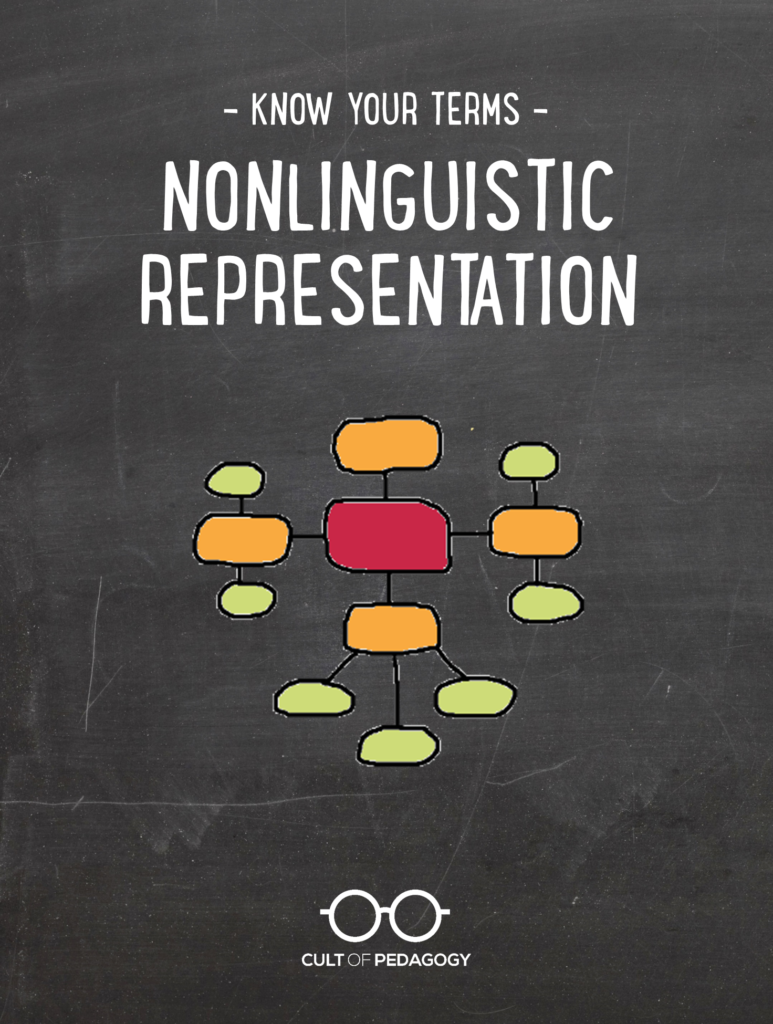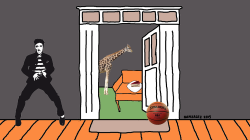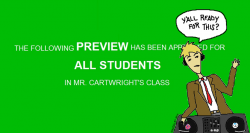
nonlinguistic representation
(noun) Expression of an idea in a way that goes beyond the use of words: diagrams, pictures, graphic organizers, 3D models, movement, demonstrations, role-plays, simulations, or mental images.
Overview: One way to teach something is to explain it, either verbally or in writing. This is a linguistic way of presenting that information — using language only. But most people learn concepts better when they are also presented in other, nonlinguistic ways: For the most part, this means visually or through some kind of movement. If you’ve ever heard a guy stop in the middle of an explanation and say Hold on, let me draw you a picture, that guy is getting ready to sit you down for a big heaping plate of nonlinguistic representation.
If you’re a teacher, you should know that nonlinguistic representation can help you make any concept stick better. Although some content areas, like PE and art, lend themselves more naturally to this technique, you’d be amazed to discover how well it works with everything else, too. Any time you notice that students aren’t “getting” something, it’s time to switch gears and stop trying to explain it with words. Your efforts don’t need to be fancy, either. Usually the tools you need to represent an idea nonlinguistically are right in front of you:
![]()
Say you’re having trouble getting your fourth graders to understand the relationship between the sun, the earth, and the seasons. Grab a couple of kids and make one be the sun and one be the earth. Then start spinning them around accordingly. From that day forward, no kid in that class will ever forget that Gina’s head got kind of cold when she moved away from Anthony.
![]() Or suppose you’ve tried to explain to your 8th graders just how many American Indians were wiped out by disease after Europeans began settling in the New World, but the numbers don’t seem to be sinking in. To get the point across, you pour 300 green M&M’s into a tray, representing the native population before European settlement. Using blue M&M’s to represent the European settlers, you read a description of key events of European settlement, adding blue candies and removing green ones as you go, until the tray is crowded with blue and students have a visual picture how small the native population has become.
Or suppose you’ve tried to explain to your 8th graders just how many American Indians were wiped out by disease after Europeans began settling in the New World, but the numbers don’t seem to be sinking in. To get the point across, you pour 300 green M&M’s into a tray, representing the native population before European settlement. Using blue M&M’s to represent the European settlers, you read a description of key events of European settlement, adding blue candies and removing green ones as you go, until the tray is crowded with blue and students have a visual picture how small the native population has become.
![]() Or maybe your seniors are sleeping through a long section of landscape description in Wuthering Heights. Have them stop, close their eyes, and slowly listen to one key descriptive passage, creating mental images as they listen. (Yes, there is still language involved here, but the focus is on the image-making and really feeling what it’s like to live on the Yorkshire moors. Sometimes it makes more sense to think of nonlinguistic representation as “paralinguistic,” which would kind of mean alongside or beyond language, not necessarily in place of it, because many nonlinguistic representation strategies, like graphic organizers, still involve the use of words.)
Or maybe your seniors are sleeping through a long section of landscape description in Wuthering Heights. Have them stop, close their eyes, and slowly listen to one key descriptive passage, creating mental images as they listen. (Yes, there is still language involved here, but the focus is on the image-making and really feeling what it’s like to live on the Yorkshire moors. Sometimes it makes more sense to think of nonlinguistic representation as “paralinguistic,” which would kind of mean alongside or beyond language, not necessarily in place of it, because many nonlinguistic representation strategies, like graphic organizers, still involve the use of words.)
If you’re a parent, you should understand that when your child comes home from school with doodles on his science worksheet, or her math homework asks her to represent an equation with pictures, the school isn’t wasting your kid’s time. Those drawings are actually part of sound instruction. You can help by asking your child to explain his picture to you, or if she is having trouble coming up with a drawing for a particular concept, brainstorm with her — the key is helping her remember the concept, and that conversation with you will help embed it even further into her brain.
What Backs it Up: Nonlinguistic representation is an incredibly powerful tool for teaching. Plenty of research supports this contention, but probably the most substantial and recent is this: In a 2009 meta-analysis on instructional strategies, Robert Marzano and his colleagues found that when teachers used nonlinguistic representation, student achievement increased an average of 17 percentile points. Not too shabby, eh?
Know Your Terms is our effort to build a user-friendly knowledge base of terms every educator should know. New items will be added on an ongoing basis. If you heard some term at a PD and didn’t want to look like a moron by admitting you didn’t know what it meant, send it to us via the contact form and we’ll research it for you. And we promise not to tell anyone you sent it: You can totally act like you knew what it meant all along.
Join our mailing list and get weekly tips, tools, and inspiration—in quick, bite-sized packages—all geared toward making your teaching more effective and fun. You’ll get access to our members-only library of free downloads, including 20 Ways to Cut Your Grading Time in Half the e-booklet that has helped thousands of teachers save time on grading. Join us!




